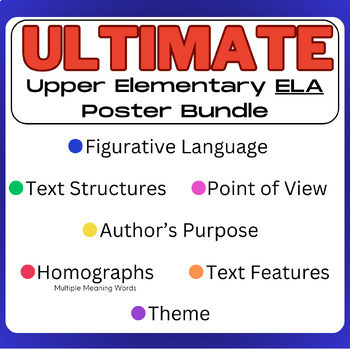ULTIMATE 3rd-5th Elementary ELA Bundle- Anchor Charts and Posters
- Zip
Products in this Bundle (9)
showing 1-5 of 9 products
Description
Bundle: ULTIMATE 3rd-5th Elementary ELA Bundle- Anchor Charts and Posters
1. Text Features - Anchor Chart Posters
The first poster starts with the definition of text features and lists the eight most common text features, including:
- Titles and Subtitles
- Headings
- Photo and Caption
- Sidebar
- Diagrams and Labels
- Tables and Graphs
- Map and Key
- Types of Print (Bold, Highlighted, Italics/italicized, Underlined.)
Each poster focuses on a single text feature, providing a definition and a colorful image to illustrate the feature.
There are 3 bonus posters included in this bundle that define the meanings of Glossary, Index, and Table of Contents.
By having these posters prominently displayed, students can refer to them as they read and analyze different texts. This can help them to understand the different ways that information is presented in a text and to identify the most important information.
2. 5 Text Structures - Anchor Chart Posters
These anchor chart posters are a valuable tool for students to use in order to understand and utilize text structures while reading. Each of the five posters in this bundle covers a different text structure.
- Description
- Cause and Effect
- Problem and Solution
- Compare and Contrast
- Sequence/Chronological.
Each poster provides a clear definition of the text structure, along with models or to help students grasp the concept. Key signal words and phrases are also included to help students identify the text structure while reading.
3. Point of View: 1st Person & 3rd Person - Posters/Anchor Charts
This bundle includes posters that define what point of view is and provides explanations of 1st person and 3rd person point of view. Each point of view is further elaborated in individual posters that include definitions, examples, and pronouns used in each POV.
The first poster defines what point of view is and how it affects a story's narration. It has a brief summary of 1st and 3rd person to help students understand the perspective from which the story is being told and how it influences the reader's understanding of the events.
The Second and Third Posters includes individual posters for 1st person and 3rd person point of view.
4. Figurative Language - Anchor Chart Posters With Definitions & Examples
Posters featuring figurative language examples with definitions and pictures can be a great tool for students and teachers alike. Each figure of speech is defined in plain language, and examples of how each is used in everyday language are provided.
By providing easy-to-understand definitions and visual aids, students can better understand and appreciate the beauty and power of figurative language.
Includes:
- Personification
- Hyperbole
- Simile
- Metaphor
- Onomatopoeia
- Idiom
- Alliteration
- Assonance
- Rhyme
5. Author's Purpose: Persuade, Inform, or Entertain? P.I.E. - Anchor Chart Posters
These posters are a great tool to use to help students remember Author's Purpose. The first poster has the definition of Author's Purpose, which is the reason why an author chooses to write a particular text. Typically, there are three main reasons why an author writes a text: to persuade, to inform, or to entertain. These three reasons are represented by the acronym PIE.
6. Theme - "TheMESSAGE" Poster Anchor Chart
An anchor chart is a powerful tool that teachers use to help students understand important concepts. If you're teaching students how to find the theme or message of a text, this is a helpful anchor chart to use when teaching student about Theme. Remembering Theme = Message or "The Message" helps students remember what they are looking for while they are reading!
7. Homographs/Homophones Multiple Meaning Words - Anchor Charts with Examples
Simple Anchor Chart with the definition of Homographs and Homophones and simple black and white images for examples.
8. Author's Perspective VS Author's Claim - Anchor Chart Posters
Help alleviate confusion when teaching Author's Perspective and Author's Claim using these handy posters. Uses simple text and phrasing and includes images for help remind students what facts, opinions, and feelings are. Reminds students to ask questions as they are reading to figure out what the author is thinking and how they feel about the topic they are writing about.
Students can use this poster as a reference while reading texts.
9. Structural Elements of Poetry - Anchor Chart Posters
This bundle of posters demonstrates different structural elements found in all types of poetry.
These posters analyze the familiar and popular children's poem "Twinkle Twinkle Little Star" as an example and demonstrates how each element is found within the poem.
The following elements are addressed:
- Verse- Refers to a single line of the poem
- Line Break- Where the line of a text ends
- Stanza- Multiple lines of the poem grouped together
- Repetition- Repeated sound, word, or line
- Rhyme- Words that have the same ending sound
- Rhythm- The beat of a poem
- Meter- A pattern of stressed and unstressed syllables


